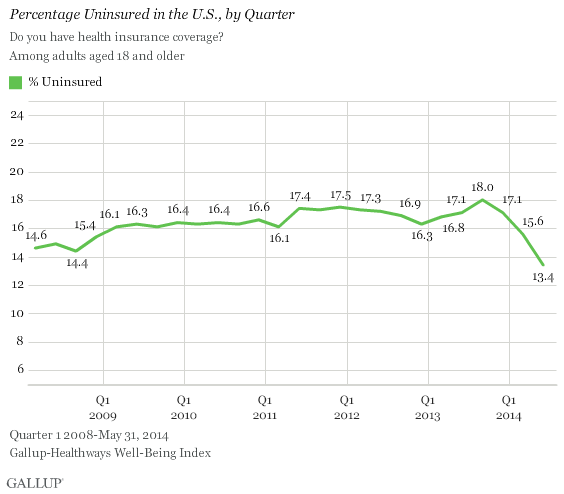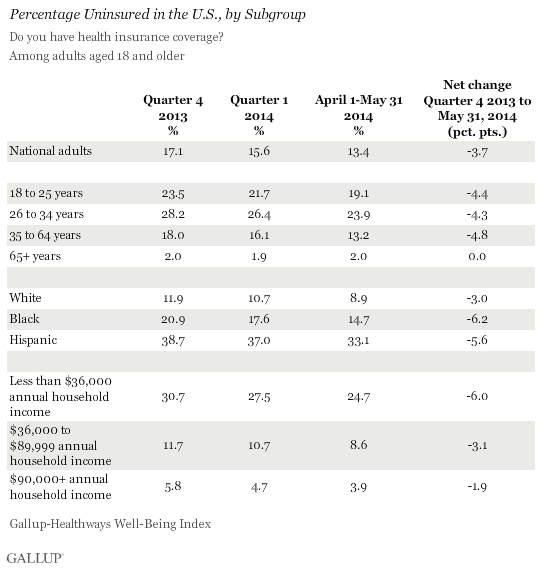WASHINGTON, D.C. -- The uninsured rate for U.S. adults appears to be leveling off since the open enrollment period for buying health insurance coverage through the marketplace ended in mid-April. The uninsured rate so far in the second quarter of 2014 is 13.4%, with the rate in April and May as individual months also averaging 13.4%, respectively.

In late March, the Obama administration extended the original April 1 deadline to buy insurance out to April 15 for those who had already begun, but not completed, the enrollment process.
The percentage of U.S. adults lacking insurance coverage in the first two months of the second quarter of 2014 is down from 17.1% in the fourth quarter of 2013 and from the 15.6% average in the first quarter of 2014. The current 13.4% average for the second quarter of 2014 is the lowest level recorded since Gallup began tracking this measure in 2008.
These data are based on more than 30,400 interviews with Americans from April 1-May 31, 2014, as part of the Gallup-Healthways Well-Being Index.
Sharpest Declines Among Blacks and Hispanics
Across nearly every major subgroup, the uninsured rate is lower now compared with the fourth quarter of 2013. The rate dropped more among blacks than it did in other major demographic groups, falling 6.2 percentage points to 14.7%.
Hispanics had the second-largest drop in the percent uninsured across demographic groups. Although the rate among Hispanics is down 5.6 points since the end of 2013 to 33.1%, this remains the highest uninsured rate across key subgroups. Hispanics are a major target of public outreach efforts, because they historically are the most likely to be uninsured among demographic groups.
Younger adults, who tend to be healthier and whose participation in the health insurance system is important to help keep costs down, are another key group targeted by outreach efforts. Those aged 26 to 34 years, however, continue to have the highest uninsured rate among all age groups. The changes seen since the fourth quarter of 2013 for this group is similar to that of 18- to 25-year-olds and that of 35- to 64-year-olds.

Implications
The nation's uninsured rate in both April and May was 13.4%, which is significantly lower than previous quarters. This rate, however, clearly shows a leveling off of the uninsured rate compared with the month-by-month declines seen in previous months. It remains to be seen if the uninsured rate will stay at this level, increase, or decrease between now and mid-November, when the next open enrollment begins. The rate could drop if more states elect to expand Medicaid. Gallup research shows that the uninsured rate, on average, has dropped more in states that have elected to expand Medicaid and run their own healthcare exchanges than in states that have not. Additionally, special enrollment remains an option for Americans who experience a "qualifying life event" such as a marriage, divorce, college graduation, or birth. Additionally, as employment rates pick up, the uninsured rate could further decrease.
Studies suggest that, by now, most newly insured Americans have paid their first premiums for their 2014 policies. However, without strong efforts to maintain retention, some newly insured Americans may not continue to pay for their insurance on an ongoing basis, thus potentially causing the uninsured rate to rise over time.
And although the healthcare law has brought down the number of uninsured Americans, a majority of Americans still disapprove of it, and many feel it has not helped them. More positive attitudes toward the law and its effect on Americans' healthcare situations may also help lower the uninsured rate.
Survey Methods
Results are based on telephone interviews conducted as part of the Gallup-Healthways Well-Being Index survey April 1-May 31, 2014, 2014, with a random sample of 30,430 adults, aged 18 and older, living in all 50 U.S. states and the District of Columbia.
For results based on the total sample of national adults, the margin of sampling error is ±1 percentage points at the 95% confidence level.
Interviews are conducted with respondents on landline telephones and cellular phones, with interviews conducted in Spanish for respondents who are primarily Spanish-speaking. Each sample of national adults includes a minimum quota of 50% cellphone respondents and 50% landline respondents, with additional minimum quotas by time zone within region. Landline and cellular telephone numbers are selected using random-digit-dial methods. Landline respondents are chosen at random within each household on the basis of which member had the most recent birthday.
Samples are weighted to correct for unequal selection probability, nonresponse, and double coverage of landline and cell users in the two sampling frames. They are also weighted to match the national demographics of gender, age, race, Hispanic ethnicity, education, region, population density, and phone status (cellphone only/landline only/both, and cellphone mostly). Demographic weighting targets are based on the most recent Current Population Survey figures for the aged 18 and older U.S. population. Phone status targets are based on the most recent National Health Interview Survey. Population density targets are based on the most recent U.S. census. All reported margins of sampling error include the computed design effects for weighting.
In addition to sampling error, question wording and practical difficulties in conducting surveys can introduce error or bias into the findings of public opinion polls.
For more details on Gallup's polling methodology, visit www.gallup.com.
